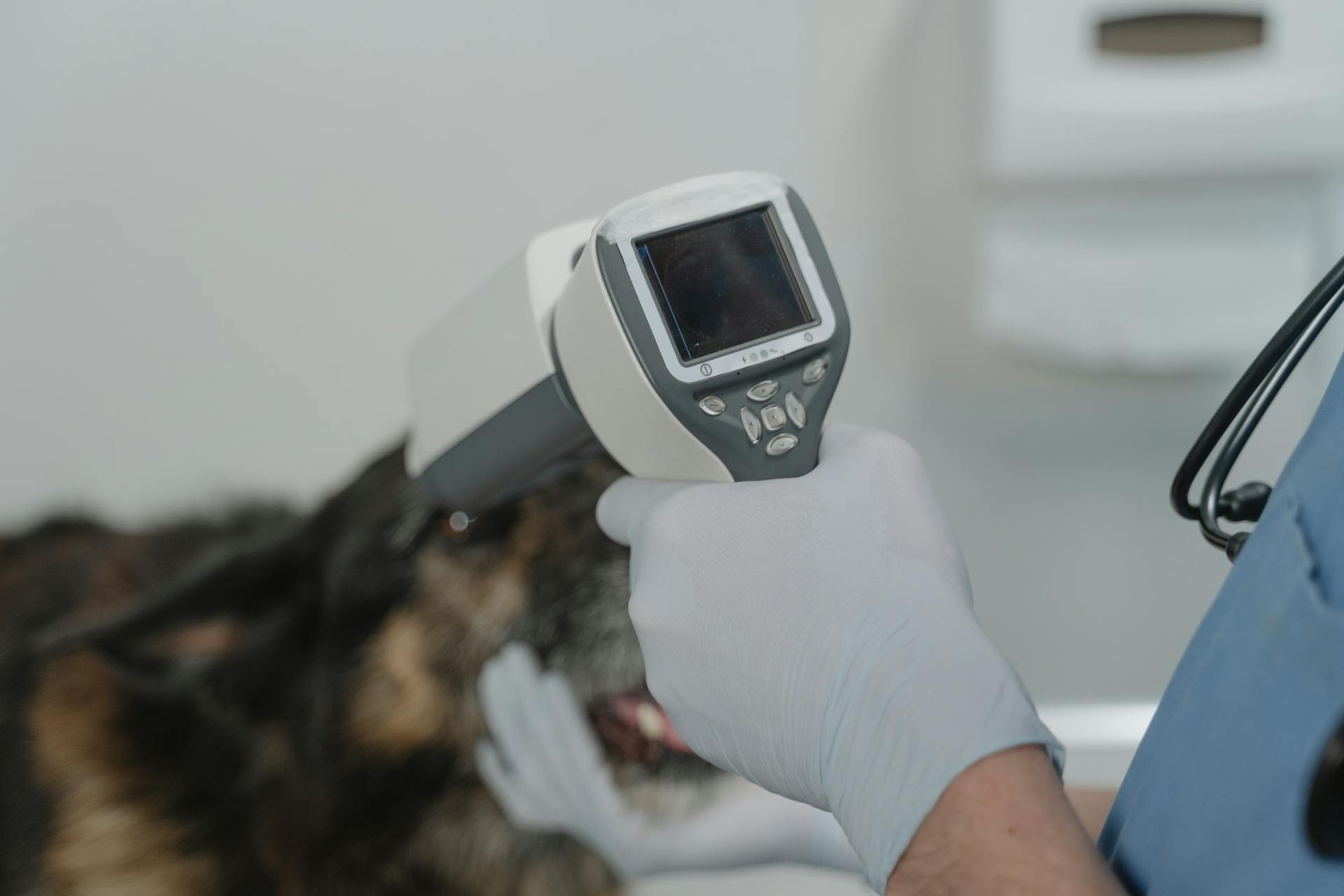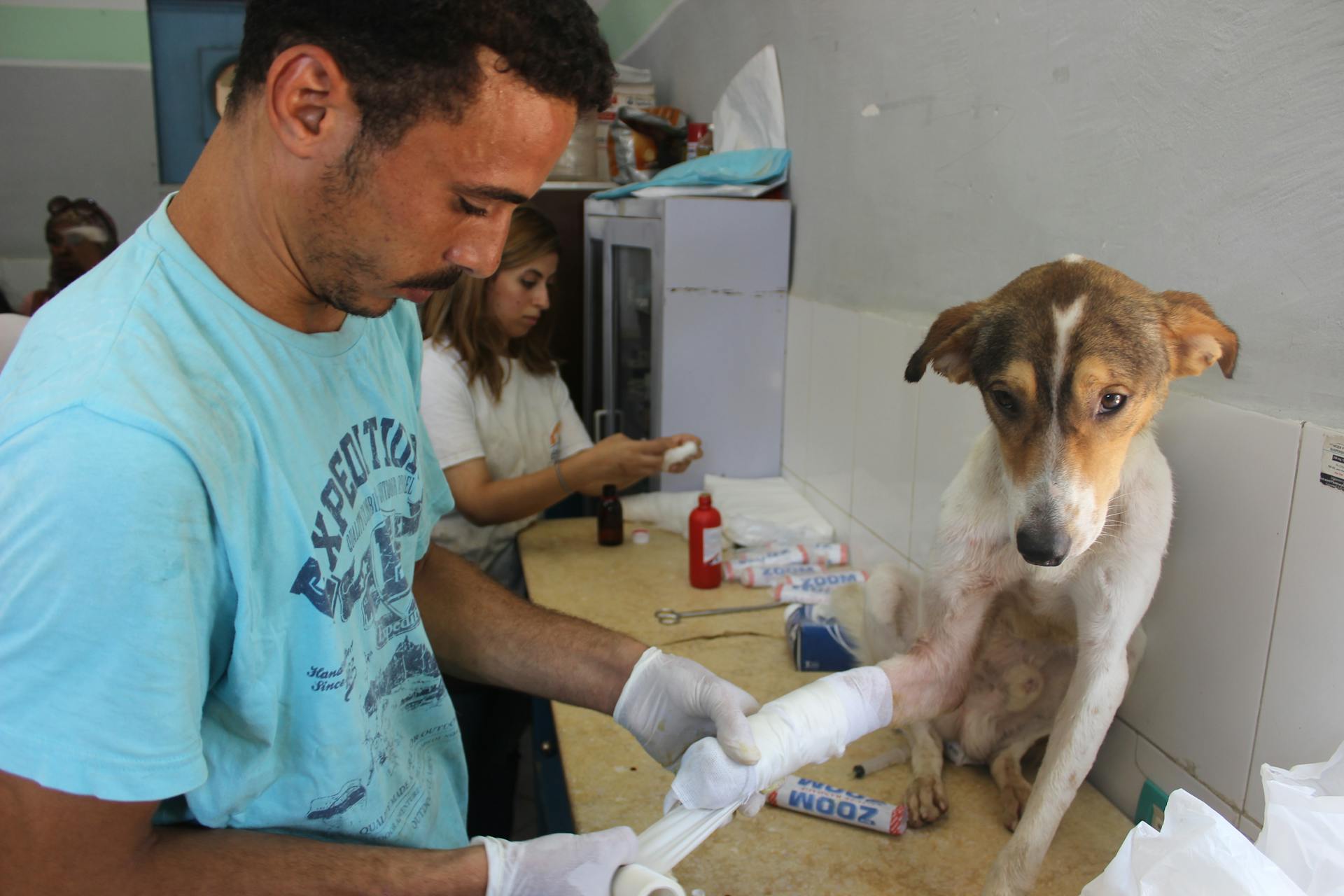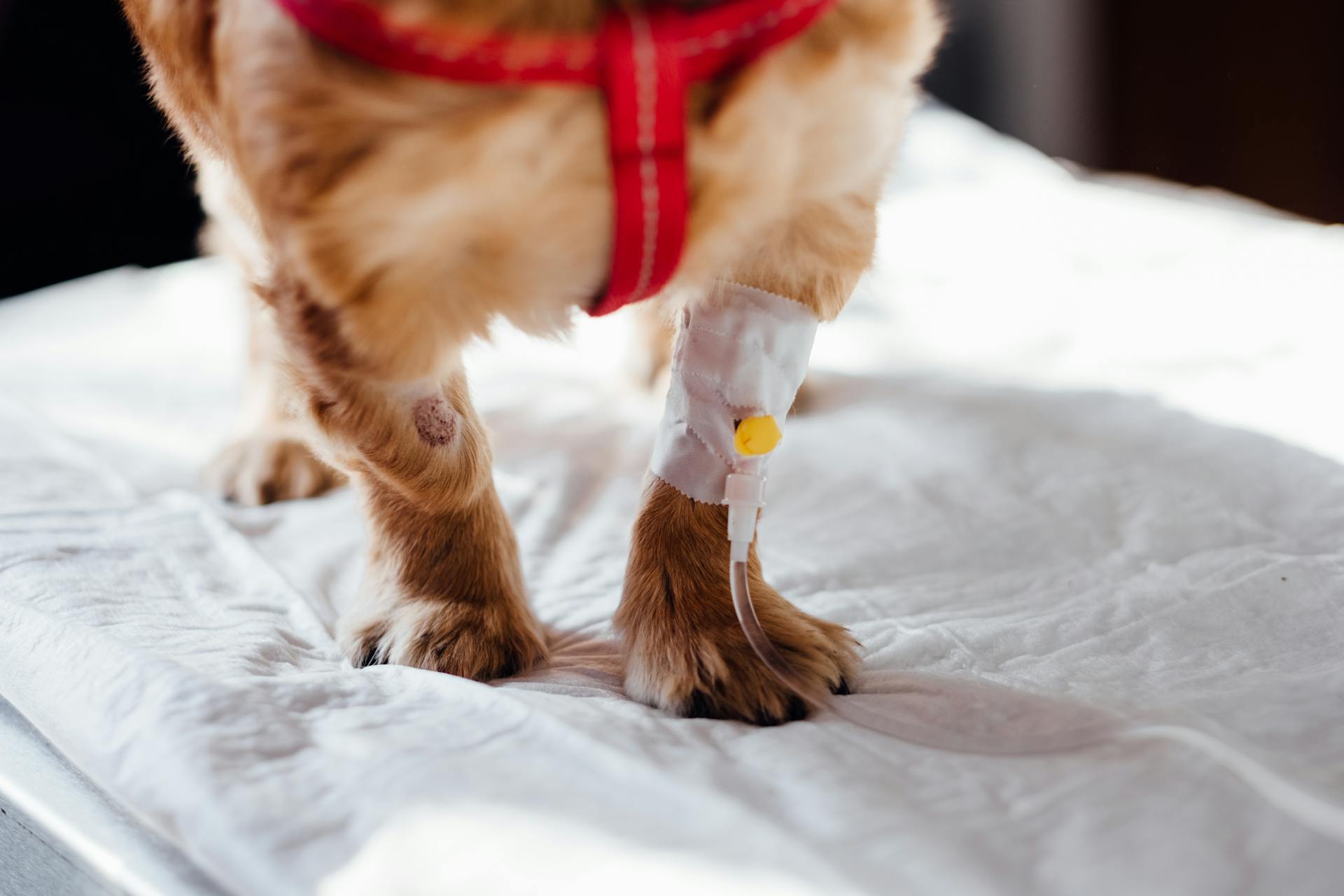
Cerenia is often used to treat pancreatitis in dogs, but prevention and recovery are just as important. Giving your dog a high-fat meal can trigger pancreatitis.
To prevent pancreatitis, feed your dog a balanced diet with moderate fat content. This can help reduce the risk of pancreatitis.
Monitoring your dog's food intake and body condition is crucial. Regular check-ups with your veterinarian can help identify any potential issues early on.
Cerenia can be administered to help manage pancreatitis symptoms, but it's essential to follow your veterinarian's instructions carefully.
What Is Pancreatitis?
Pancreatitis is common in dogs and is usually caused by eating something they shouldn't have, like trash, table scraps, or fatty treats.
Dogs with pancreatitis may have obvious signs like vomiting, dehydration, fever, and belly pain, or they might just seem listless and have diarrhea.
Pancreatitis is a serious illness that can cause damage to your dog's other organs, and if left untreated, it can be fatal.
The pancreas enzymes activate too early and start digesting the pancreas and other organs, which can lead to organ failure.
Dogs with mild cases of pancreatitis have a good chance of recovery, but those with severe cases may not recover, especially if they have organ failure.
The best way to prevent pancreatitis is to carefully watch what your dog eats and avoid giving them fatty foods.
Causes and Prevention
Causes of pancreatitis in dogs can be sneaky, but there are some common culprits. A high-fat diet is the most common cause, especially if your dog gorges on fatty foods in one sitting. This can happen on special occasions like Thanksgiving, when table scraps are plentiful.
Some breeds are more prone to pancreatitis, including miniature schnauzers, Yorkshire terriers, cocker spaniels, and poodles. If you have one of these breeds, be extra vigilant about their diet.
Certain toxins and medications can also cause pancreatitis. These include cholinesterase inhibitors, calcium supplements, and certain anticonvulsant medicines. Always keep these out of reach of your dog, especially if they're a curious eater.
Recommended read: Can Stress Cause Pancreatitis in Dogs
Here are some common toxins and medications that can cause pancreatitis in dogs:
Preventing pancreatitis is easier than treating it. Start by monitoring your dog's food intake and avoiding fatty foods and table scraps. Keep your kitchen garbage secure, and store medications and supplements out of reach.
What Causes Pancreatitis?
Pancreatitis in dogs can be a sudden and mysterious condition, but research has shed some light on its causes. A high-fat diet is the most common cause of pancreatitis in dogs, especially if they gorge on fatty foods in one sitting.
Eating a lot of fatty table scraps can trigger pancreatitis, as seen in the spike in emergency vet visits after Thanksgiving in the U.S. It's a good idea to keep a close eye on what your dog eats to prevent this.
Some breeds and breed mixes are more prone to pancreatitis than others, including miniature schnauzers, Yorkshire terriers, cocker spaniels, dachshunds, poodles, sled dogs, and some toy or small terrier breeds.
Take a look at this: Dog Breeds Watch Dogs
Dogs that eat whatever they can find to eat, including people food from the garbage or table scraps, are at a higher risk of developing pancreatitis.
Certain toxins and medications can also trigger pancreatitis in dogs. These include:
- Cholinesterase inhibitors
- Calcium supplements
- Potassium bromide and phenobarbital
- L-asparaginase
- Estrogen
- Aspirin and aspirin-containing medicines
- Azathioprine
- Thiazide diuretics
- Vinca alkaloids
Dietary indiscretion, genetics, high-fat diets, and certain medications can all contribute to pancreatitis in dogs.
Preventing in Dogs
Preventing pancreatitis in dogs is crucial to their health and well-being.
Closely watching your dog's food intake is the most important step in preventing pancreatitis. You should avoid feeding them fatty foods or table scraps, and keep all medicines and supplements out of their reach.
Some supplements may help reduce the risk of pancreatitis in your dog. Digestive enzyme supplements, such as pancreatin, can reduce the work your dog's pancreas has to do to digest their food.
Fish oil supplements can also help lower your dog's lipid levels, which may trigger pancreatitis in some dogs. However, always talk to your vet before giving your dog any supplements.
Diagnosis and Confirmation
Your veterinarian will likely start by performing a physical exam to look for signs of pancreatitis, such as a swollen belly or vomiting.
A key test for diagnosing pancreatitis is a blood test to measure the amount of enzymes your dog's pancreas is making, specifically pancreatic lipase immunoreactivity (PLI).
Abdominal X-rays or ultrasound may be done to rule out other conditions that could cause your dog's symptoms, such as something getting stuck in their stomach or intestines.
A fine needle aspirate of your dog's pancreas can also be used to look for signs of swelling and infection.
Your veterinarian may also do a blood test to measure white blood cell count, platelets, kidney values, electrolyte abnormalities, and amylases and lipases.
Here are some common blood tests used to diagnose pancreatitis:
A negative result from the SNAP test can rule out pancreatitis, but a positive result requires further testing to confirm the diagnosis.
Signs of Pancreatitis
If your dog is showing signs of pancreatitis, it's essential to act quickly. The most common signs of severe pancreatitis in dogs include loss of appetite or refusal to eat, repeated vomiting, and weakness or listlessness.
If your pup has been vomiting for more than a day, they need to visit the vet. This is a critical sign that requires immediate attention.
Dogs with pancreatitis may also display belly pain, which can be hard to detect. You may notice your dog standing with a hunched back or looking uncomfortable or bloated.
If your dog's condition is getting worse, look out for these critical signs: a bloated, hard belly, vomiting and diarrhea that isn't getting better, trouble breathing or swallowing, seizures, inability to drink, and inability to stand up on their own.
Here are some key symptoms to watch for:
- Bloated, hard belly
- Vomiting and diarrhea that isn't getting better
- Trouble breathing or swallowing
- Seizures
- Unable to drink
- Unable to stand up on their own
Keep in mind that dogs with milder cases of pancreatitis may not display these obvious signs, or they may only have a couple of signs that could be caused by many different things.
Treatment and Nutrition
If your dog has pancreatitis, it's essential to get them to the vet as soon as possible. Pancreatitis can be a serious illness that can kill your dog, so don't delay.
Your vet will try to find out what caused the pancreatitis so they can deal with that and hopefully prevent it from happening again. They may take your dog off a certain medication or switch it for something else if that's what caused the pancreatitis.
In the first 24 hours, your vet may want you to withhold food and water if your dog can't keep anything down. They may also recommend pain medicine, IV fluids, and medicine to prevent vomiting and dehydration.
Enteral feeding, where nutrition is provided through the digestive system, is now accepted as a better approach than withholding oral food and water for more than 48 hours. This can help reduce the potential for bacterial infection and may reduce the time your dog needs to be hospitalized.
For more insights, see: How to Prevent Pancreatitis in Dogs
If your dog has mild pancreatitis, they may start eating slowly with supportive care. If their appetite doesn't return within 48 hours, feeding tubes may be recommended. Tubes can also be used for hydration and administering medications.
Your vet may recommend a prescription dog food that's low fat or ultra low fat, at least until your dog gets better. If your dog has chronic pancreatitis, they may have to eat a low-fat diet for the rest of their lives.
Here are some general guidelines for a low-fat diet:
- Low-fat meats such as chicken breast (if your dog isn't allergic) or lean beef
- Beef organs (kidney, heart, and liver)
- Rice and barley
- Egg whites
- Yogurt (make sure it's plain, low-fat, and doesn't have any xylitol)
- Cooked vegetables
Once vomiting is under control, water is slowly introduced, with a few laps or ice cubes every hour or so. If your dog keeps this down, liquids are tried next, followed by soupy, low-fat, high-carbohydrate foods. Frequent small amounts are less likely to cause problems than larger quantities, particularly in the beginning.
Comfort and Care
As your furry friend recovers from pancreatitis, it's essential to prioritize their comfort and care. Allow your pup to rest in a quiet place, away from children and other pets, to help them feel more at ease.
Limit playtime and walks to avoid exacerbating their condition. If your dog has a favorite safe space, let them rest in their bed there.
Make sure they have access to water at all times, especially if they're having trouble walking or standing. If necessary, place a water bowl close to their bed to prevent them from having to move far to get a drink.
Monitor your pup closely for any new signs or worsening symptoms, and don't hesitate to call the vet if you notice anything unusual. Your vet will provide guidance on the best course of action.
Here are some essential care tips to keep in mind:
- Provide a comfortable and quiet space for your pup to rest.
- Limit playtime and walks to avoid exacerbating their condition.
- Ensure access to water at all times.
- Monitor your pup closely for any new signs or worsening symptoms.
Dog Food and Nutrition
If your dog has pancreatitis, their vet may recommend a prescription dog food that's low fat or ultra low fat, at least until they get better. This is because a high-fat diet can trigger pancreatitis in some dogs.
A low-fat diet can help manage pancreatitis, and your vet may recommend a commercial food that's formulated to meet your dog's needs. However, some dogs may not like their new food, so you can try making your own dog food with the help of your vet or a veterinary nutritionist.
If this caught your attention, see: Veteran Dog Treats
To make your own dog food, focus on low-fat meats like chicken breast or lean beef, beef organs, rice and barley, egg whites, plain low-fat yogurt, and cooked vegetables. Your vet can help you determine the best ingredients and portion sizes for your dog.
Here are some general guidelines for making your own dog food:
Dog Food
For dogs with pancreatitis, the right dog food can make a big difference. Your vet may recommend a prescription dog food that's low fat or ultra low fat, especially if your dog has acute pancreatitis. Chronic pancreatitis might require a low-fat diet for life.
You can feed your dog a commercial food that meets their needs, but some dogs may not like the change. If your dog is having trouble adjusting, you can try making your own dog food, but it's essential to talk to your vet or a veterinary nutritionist first. They'll help you create a diet that meets your pup's nutritional needs.
Your dog's nutritional needs depend on many factors, including their weight, life stage, health status, and allergies. To make your own dog food, focus on low-fat meats like chicken breast or lean beef, beef organs like kidney, heart, and liver, rice and barley, egg whites, plain low-fat yogurt, and cooked vegetables.
Here are some specific ingredients to consider:
- Low-fat meats: chicken breast, lean beef
- Beef organs: kidney, heart, and liver
- Rice and barley
- Egg whites
- Plain low-fat yogurt
- Cooked vegetables
Canine
If your furry friend has pancreatitis, it's crucial to get them to the vet ASAP. Pancreatitis is a serious illness that can be fatal if left untreated, so don't even think about trying to treat it at home.
Your vet will likely try to figure out what caused the pancreatitis, and if it was due to a reaction to a medication, they may switch your pup to a different one. If it was caused by something in their diet, they may put them on a low-fat or ultra-low-fat prescription food.
In the first 24 hours, your vet may recommend withholding food and water if your dog can't keep anything down. Then, over the next week or so, they may prescribe pain medicine, IV fluids, and medicine to prevent vomiting and dehydration.
A low-fat diet is often recommended, and your vet may also prescribe Fuzapladib sodium (Panoquell-CA1) to prevent ongoing inflammation in your dog's pancreas.
If your pup has chronic pancreatitis, your vet may prescribe cyclosporine, prednisone, or prednisolone.
To prevent pancreatitis in the first place, it's essential to monitor your dog's food intake closely. Avoid feeding them fatty foods or table scraps, and keep all medicines and supplements out of reach.
Some supplements that may help prevent pancreatitis include digestive enzyme supplements (pancreatin) and fish oil supplements, which may help lower lipid levels. However, always consult with your vet before giving your dog any supplements.
During an acute pancreatitis attack, it's no longer recommended to withhold food and water completely. Instead, your vet may recommend enteral feeding, which involves providing nutrition directly to the digestive system through a tube.
Enteral feeding can be done through a nasogastric tube, which is inserted into the nose and goes down into the stomach. Alternatively, an esophagostomy tube can be used, which is inserted into the esophagus and allows for longer-term feeding.
If your pet's appetite doesn't return within 48 hours, feeding tubes may be recommended. These tubes can be used for hydration and administering medications, and are typically well-tolerated in cats and dogs with few complications.
Here are some common feeding tubes used in canine patients:
It's worth noting that nasoesophageal (A) and esophagostomy (B) tubes are often used in hospitals for nutritional support.
Recovery and Prevention
Recovery from pancreatitis in dogs requires a gentle approach to food intake. Dogs should start with small amounts of water, then liquids, and eventually soupy, low-fat, high-carbohydrate foods.
Frequent small meals are less likely to cause problems than larger quantities, especially in the beginning. This approach helps the dog's pancreas recover from the inflammation.
To manage pain during recovery, dogs may be sent home with pain medication, such as a Fentanyl patch or Tramadol. Controlling pain is crucial to ensure a smooth recovery.
To prevent pancreatitis in the future, it's essential to monitor your dog's food intake closely. Avoid giving them fatty foods or table scraps, and keep all medications and supplements out of their reach.
Discover more: What Foods Cause Pancreatitis in Dogs
Preventing Recurrence

Feeding your dog a balanced diet is crucial to preventing pancreatitis from coming back. Stick to their regular food and avoid giving them table scraps or fatty foods.
Digestive enzyme supplements like pancreatin can help reduce the work your dog's pancreas has to do to digest their food. However, this may not help all dogs, so ask your vet if they think it will help your dog.
Fish oil supplements can help lower your dog's lipid levels, which may trigger pancreatitis in some dogs. The recommended dosage is 1,000 milligrams of fish oil per 10 pounds of body weight, along with 5-10 IU of vitamin E.
Recovering from Acute
Recovering from acute pancreatitis requires patience and careful nutrition.
The goal is to reintroduce food gradually, starting with small amounts of water, then liquids, and eventually soupy, low-fat, high-carbohydrate foods.
Frequent small meals are less likely to cause problems than larger quantities, especially in the beginning.
Consider reading: Service Dog Vest for Small Dogs

Dogs can return home from the hospital once they can keep food down without vomiting.
Pain medication, such as a Fentanyl patch or Tramadol, may be prescribed to control discomfort during recovery.
A fat-restricted prescription diet is often recommended for dogs with pancreatitis, especially if they are overweight or have hyperlipidemia.
However, if your dog won't eat the prescription food or reacts poorly to it, you can try transitioning them back to a better quality commercial or homemade diet.
Frequently Asked Questions
Is Cerenia safe for dogs with pancreatitis?
Yes, Cerenia can be used to treat nausea and vomiting caused by pancreatitis, but consult with a veterinarian to discuss the best treatment plan for your dog. Cerenia is often prescribed in conjunction with other treatments to manage pancreatitis symptoms.
What is the best medication for dogs with pancreatitis?
For dogs with pancreatitis, medications like maropitant, ondansetron, and metoclopramide can help manage symptoms, while appetite stimulants like mirtazapine or capromorelin may be prescribed to support recovery. Consult with a veterinarian to determine the best treatment plan for your dog.
Does Cerenia reduce inflammation in dogs?
Yes, Cerenia is used to reduce inflammation in dogs. It's also effective for relieving pain and addressing other health issues.
How do you stop a dog from throwing up with pancreatitis?
Fasting your dog for 12-24 hours may be recommended to stop vomiting, while more severe cases may require hospitalization and aggressive treatment
Sources
- https://www.webmd.com/pets/dogs/dog-pancreatitis-symptoms-and-treatment
- https://www.whole-dog-journal.com/health/canine-pancreatitis/
- https://www.dvm360.com/view/what-pain-gut-canine-pancreatitis
- https://www.medvet.com/pancreatitis-in-pets/
- https://www.dogfoodadvisor.com/forums/topic/pancreatitis-recovery/
Featured Images: pexels.com


